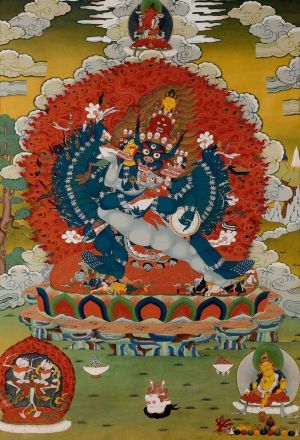Ring brgyud kyi gsol ‘debs ma gcig gis mdzad par ban sgar ‘jam dpal bzang pos kha bskang ba Ideb
by Michelle Janet Sorensen
Lineage supplications are so informative—and so confusing. This one is not mentioned in Kongtrul’s Catalog, except perhaps as one of the branches (yan lag rnams bcas) of Source of All Qualities, leading the editor of the table of contents of the Kundeling printing to assume that it belongs with the Zurmang feast activities. While that may be the case, it does not represent the Zurmang long lineage. That supplication can be found in Source of All Qualities,
where it is attributed to Samten Rinchen of Lhapu. And the same one is used as the basis for the whole story of the lineage in the history of Zurmang, where it is also called the “supplication of the Severance lineage gurus by Bengar Jampal Zangpo.”[1] That version and the one in Source of All Qualities are identical, despite the differing author identification. The version here may have been added to that liturgy to ensure that all relevant lineages were duly honored.
Here, the lineage is similar only up to Machik Lapdrön herself. It then veers over to Machik’s grandson Khambuyale rather than coming through Machik’s son Döndrup. Then it takes us the long way through a very Kamtsang line of lamas, including the purported author Bengar Jampal Zangpo, right up to Situ Pema Nyinje (1774–1853). This is where the lineage ends in this text as found in the Kundeling edition of the Palpung prints. However, at this point in the
Shechen printing sponsored by Dilgo Khyentse Rinpoche (1910–1991), it continues from Pema Nyinje to Jamgön Kongtrul Lodrö Taye (1813–1900), then to the Fifteenth Karmapa, Khakhyap Dorje (1871–1922), then to Kongtrul’s disciple Tashi Özer (1836–1910), then to Khyentse Özer (1896–1945),[2] and ends in “my root guru.”
How could Bengar Jampal Zangpo, who lived in the fifteenth century, have written such a contemporary addendum, let alone Machik Lapdrön? One scenario is that Machik uttered a prayer to her lineage using the place-and-name format, beginning with, “In the palace of dharmadhātu in Akaniṣhṭa, the Great Mother Perfection of Wisdom has blessings” and ending with her teacher Kyotön Sönam Lama (who is in fact skipped over here, although he is named in the Zurmang
version). Then the well-known author Bengar Jampal Zangpo picked up the trope and continued it up through his guru, the Sixth Karmapa, Tongwa Dönden (1416–1453). After that, the prayer in all its various forms came to be known simply as Bengar’s supplication. Jamgön Kongtrul himself must have continued the supplication style through to his teacher Pema Nyinje before the blocks were printed at Palpung. From Kongtrul on, the last stretch may have been added for
the Shechen printing of the Treasury. Variations of this style can also be found in the Kagyu Feast Liturgy and Kongtrul’s supplication Essence of Auspicious Renown in this volume, as well as in the popular Severance compilation known as Precious Garland (Rin chen phreng ba).
